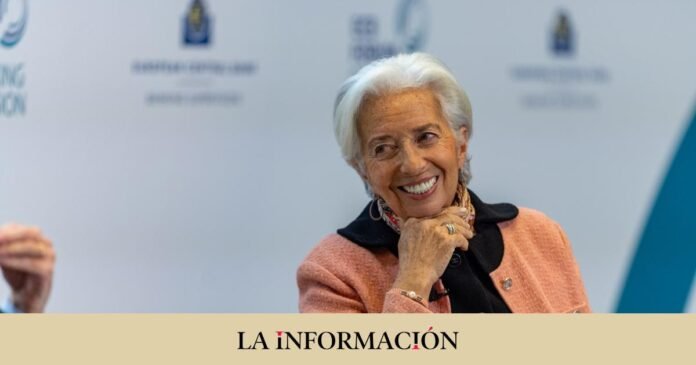The European Central Bank (ECB) is about to fall behind again in the interest rate cycle. It already happened at the beginning and it can happen again at the end. The slow monetary transmission process will continue to make most loans or longer-term debt more expensive throughout 2024, even if the central bank lowers rates, as experts warn. However, it is no longer the general picture.
In fact, interbank rates are beginning to signal an imminent reduction in financing costs for some types of financing as early as this month. The curve has inverted with the long term above the short term. It is due to the collapse of the 12-month Euribor to the lowest since April 2023 (3.72%) in its daily price. After nine consecutive negative sessions, the monthly average for December has slipped below 3.8%, according to provisional data consulted by ‘La Información’.
This new scenario would make it cheaper, for example, the cost of some housing loans referenced to the 1-year index, however, are reviewed every six months. This is the case of the Open variable mortgage from Openbank (Banco Santander), or the variable mortgage with a fixed and mixed initial tranche from ING, which also include semiannual rate reviews, according to their websites. However, it all depends on the exact conditions of the loans signed by the client.
Taking the provisional 3.78% as a reference, and if we reach the end of the month, the reviews of this type of mortgages in December compared to May (6 months) would contain a slight saving in the installments, the first since the end of 2021 when the Euribor was still negative and marked its historical minimum at -0.515%. Specifically, 0.1 percentage points or 10 basis points would reduce the cost of this liability by about 8 euros per month (96 euros annually). On the other hand, loans with the pure reference of the 6-month index will still have to wait to notice this change because their price still averages more than 3.95% compared to 3.71% in May.
Where imminent improvements may also occur is in bank financing for companies, where one of the references is the 3-month Euribor plus the bank’s commission. In this case, the index is still trading above the 6-month and 12-month term. This is expected to continue as deeper interest rate cuts continue to be factored in by the end of next year.
Recession, Lagarde and the ECB speech
At the close of the session this Friday, the profitability horizon of the Spanish sovereign debt also began to show anomalies with the 5-year bond showing a yield of 2.89% compared to 2.9% for 3 years and 3.15% for two years. However, the 10-year bond still returned 3.3%. In the case of the German bund, the short term (2 years) yielded 2.7% while the 10-year term offered only 2.27%. This inverted curve is considered a sign of recession in which you pay more for shorter-term capital and more for long-term capital, despite the temporary risk.
The market has clearly positioned itself towards easing rates and abandoning the ECB’s current restrictive stance. Investors who have bet heavily on stock markets and bonds in recent weeks are swimming in these expectations. However, the European Central Bank (ECB) will have the last word next Thursday, December 14, when it announces its decision and publishes its new table of macroeconomic projections for 2024 and 2025.
“Seeing that the ECB is already cutting [tipos] at the end of the first quarter would be crazy in our opinion. “We agree that the March 2024 forecasts could indicate stronger confidence in Frankfurt that inflation is quickly coming back under control, but we still think that such a change is more likely by June 2024,” says Gilles Moëc, economist . head of AXA Investment Managers, although he also remembers that everything depends on the data.
“While from a ‘normative’ point of view plausible macroeconomic scenarios would suggest rapid and substantial cuts in 2024, we believe we must take into account the ‘narrative inertia’ of the ECB: changing the political discourse often takes time, even when the “data moves. In the meantime, the market may have to focus on the balance sheet aspects of the ECB’s monetary policy,” adds Möec, referring to the bank’s portfolio reduction.
The evolution of the Euribor is closely linked to the rate framework set by the ECB, as well as the future orientation perceived from its speech. Then it is the banks themselves who, under conditions, in their daily trading set levels that are not usually too far from the forecasts on monetary policy. After raising them to 4.5% in September and maintaining them at that level in October – with the deposit rate at 4% -, indices such as the Euribor are trading with a discount of 0.8 percentage points for 12 months or 0.6 points at 3 and 6 months.
There are those who believe that the markets have over-braked on the hypothesis of possible rate cuts in the euro zone. “Ahead of the ECB’s December meeting, there is growing evidence that the Governing Council is divided on the message being presented to the markets. Isabel Schnabel dropped strong dovish hints as she ruled out rate hikes this week “, and markets are now pricing in 135 basis points of cuts in 12 months. We see a good chance that the overall message from this meeting will fall short of supporting aggressive rate cut expectations,” say Francesco Pesole and Benjamin Schroeder of ING.

